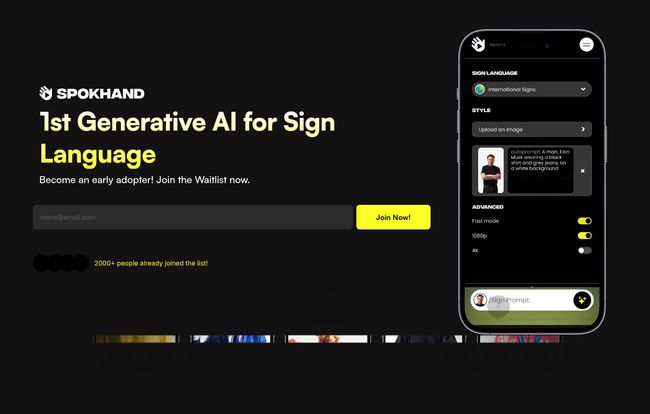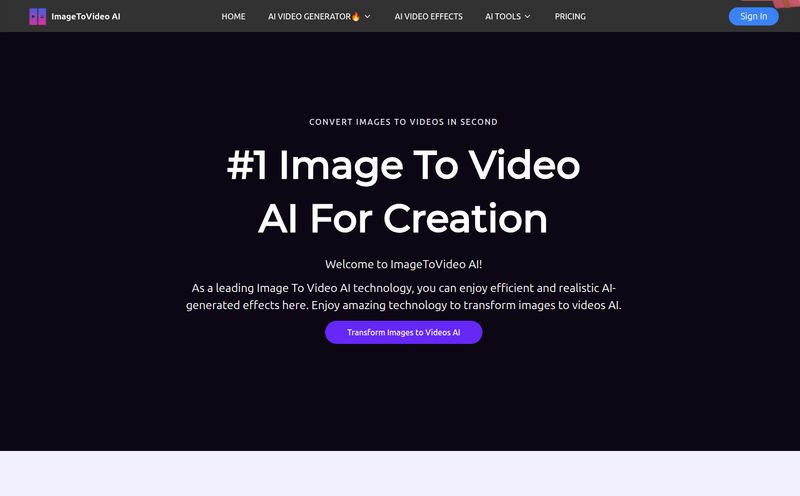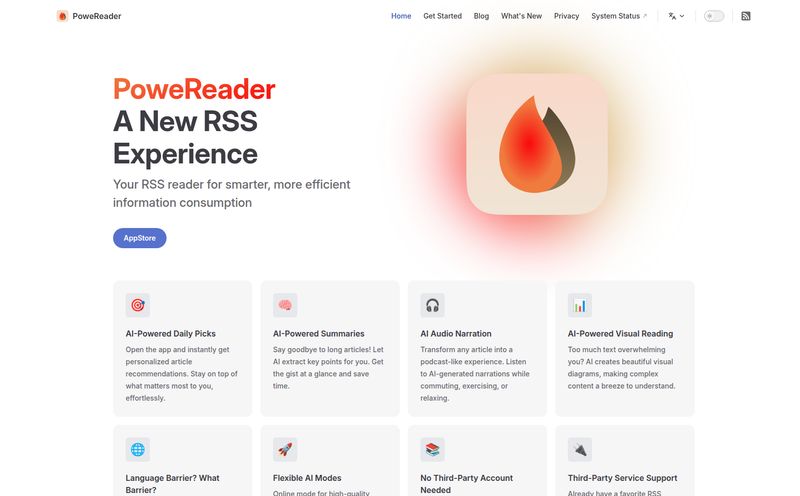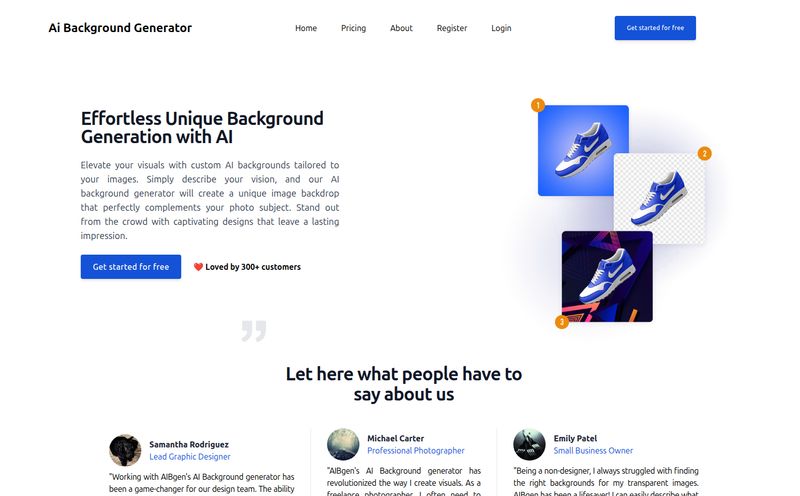You know how it is. You're scrolling through your feed, probably putting off a keyword research report, when something stops you dead in your tracks. It’s not another cat video or a hot take on the latest Google update. It’s something… different. Something that makes the little SEO-nerd part of your brain and the “just a human trying to be decent” part of your brain light up at the same time.
That was me when I saw SPOKHAND. The tagline hit me first: “1st Generative AI for Sign Language.”
Honestly, my jaw dropped a little. We've been so wrapped up in AI that writes blog posts, creates images from thin air, and codes websites, that we sometimes forget its potential to solve genuinely human challenges. This felt like a splash of cold, refreshing water. It’s one of those ideas that feels so obvious in retrospect, yet so groundbreaking in its execution, that you can't help but wonder why it didn't exist before.
So, What is SPOKHAND, Exactly?
Let's get the jargon out of the way. SPOKHAND is a generative AI platform designed to bridge the communication gap between the hearing and the Deaf and Hard of Hearing communities. The name itself is a clever portmanteau of Spoken and Hand, which is a perfect little encapsulation of its mission.
At its core, it translates typed text into sign language, which is then performed by a clean, clear virtual avatar. Think of it like Google Translate, but instead of spitting out text in another language, it gives you a visual, signed interpretation. It’s a tool for translation, learning, and most importantly, connection.
The company says it best themselves: “everyone deserves to be heard and understood.” And man, in a world that’s getting louder and more crowded online, that sentiment hits hard.
How This AI Magic Actually Works
From what I've gathered from their site, the process seems incredibly straightforward, which is always a good sign. It's built on three main pillars, catering to different needs.
First, there's the direct communication tool. A hearing person—say, a manager wanting to communicate clearly with a deaf employee, or a friend wanting to send a meaningful message—can type their text. SPOKHAND’s AI then generates the message in sign language through the avatar. Simple. Powerful.
Second, and this is a feature I find particularly thoughtful, is the option for anonymous sign language messaging for deaf individuals. It provides a layer of privacy, allowing people to share personal experiences or seek advice within their community without revealing their identity. That’s an understanding of user needs that goes beyond just the basic tech.
And third, the business application. Companies can create their own customized corporate virtual avatars to make their digital content accessible. We’re talking websites, training videos, marketing materials—you name it.

Visit SPOKHAND
More Than Just a Tool, It’s a Shift in Digital Accessibility
As someone who's spent years telling clients to “add alt text to your images” and “make sure your site is navigable by keyboard,” this feels like a quantum leap. For too long, digital accessibility, or “a11y” as we call it in the industry, has been treated like a checklist for compliance. It often feels like bolting an accessibility ramp onto the side of an existing building. It’s functional, sure, but it's an afterthought.
SPOKHAND feels different. This isn't just about compliance; it's about genuine inclusion. It’s redesigning the doorway from the ground up. Imagine a world where every piece of online content, every company announcement, every educational video could have a sign language option with the click of a button. That’s huge.
It reminds me a bit of the early days of voice search. People were skeptical, thought it was a gimmick. Now, my kids can’t imagine a world without asking a smart speaker for the weather. SPOKHAND feels like it has that kind of potential, but for a community that has been historically and profoundly underserved by technological leaps.
The Smart Business Case for Inclusivity
Let’s put on our marketing hats for a second. The feature that lets businesses create custom virtual avatars is brilliant. It’s not just about making your content accessible; it’s about branding that accessibility.
Your Brand's Signing Avatar
Imagine your company’s avatar, perhaps even subtly designed with your brand colors or style, communicating your message in sign language on your homepage. That’s not just a tool; it’s a statement. It tells the world, and specifically the Deaf community, “We see you. We value you. We want to communicate with you directly.” In my book, that's not just smart business that builds brand loyalty, it's just… good humaning.
Beyond the Website
This goes way beyond the website. Think about internal HR communications, public service announcements, online learning platforms, and even social media marketing. The ability to produce sign language content at scale, without the significant logistical challenges of hiring and filming interpreters for every single piece of content, is a massive opportunity.
Okay, Let's Be Real: The Potential Hurdles and Questions
Now, I’m a professional skeptic—it comes with the territory. As exciting as this is, I have questions. My excitement is balanced with a healthy dose of realism.
Sign language is not just a collection of hand gestures. It’s a rich, complex language with its own grammar, syntax, and—critically—non-manual markers. Facial expressions, the tilt of a head, the raising of eyebrows… these are all integral parts of the meaning. Can a virtual avatar, no matter how advanced, truly capture that nuance? I’m not sure. I’ve seen some of the video demos, and while impressive, they do have that tell-tale smoothness of an animation. The soul of the language is a high bar to clear for any AI.
Then there's the accuracy of the AI translation itself. Anyone who has used translation software for spoken languages knows it can sometimes miss idioms, context, and tone. For sign language, where precision is everything, the stakes are even higher. I suspect this will be an ongoing process of refinement for the SPOKHAND team.
But here’s the thing: these aren’t reasons to dismiss it. They are the challenges that come with any pioneering technology. The first automobile wasn’t a supercar, and the first computer took up an entire room. This is step one. And it’s a hell of a step.
The Big Question: What's the Price?
Here’s the rub—I don’t know. As of right now, SPOKHAND is in a pre-launch phase. Their website prominently features a call to action to “Join The Waitlist.”
And people are listening. The site boasts that over 21,000 people have already signed up. That’s some serious early traction and a powerful piece of social proof. It tells me the need is real and the anticipation is high.
If I had to guess, I'd imagine a tiered model. Maybe a free version for basic, personal use with some limitations, a monthly subscription for power users, and enterprise-level pricing for the custom corporate avatar features. But that's just speculation from an old marketing hand. For now, the best we can do is get on that waitlist and watch this space.
Frequently Asked Questions About SPOKHAND
I've been getting some DMs about this, so let's clear up a few common questions.
What is SPOKHAND in simple terms?
SPOKHAND is an AI tool that translates written text into sign language using a virtual avatar. It's designed to help hearing and deaf people communicate more easily and to help businesses make their content more accessible.
Is SPOKHAND available to use right now?
Not yet. It's currently in a pre-launch phase. You can go to their official website to join a waitlist to be one of the first to get access when it becomes available.
Who is this tool for?
It's for a wide range of people: hearing individuals who want to communicate with deaf friends or family, members of the Deaf community who might want to use its communication features, and businesses or organizations that want to create inclusive, accessible content.
Will it support all sign languages, like ASL, BSL, etc.?
The website doesn't specify which sign languages will be supported at launch. Typically, technologies like this roll out with one primary language, often American Sign Language (ASL), before expanding. It's a safe bet they'll aim to include more languages over time.
How accurate can we expect the AI translations to be?
This is the million-dollar question. As with any generative AI, accuracy will be a key development focus. Early versions may have limitations, especially with complex or nuanced sentences. We should expect it to improve significantly over time with more data and user feedback.
Can I really get a custom avatar for my company?
Yes, this is one of the standout features for businesses. SPOKHAND offers the ability to create customized corporate virtual avatars to represent your brand and deliver your messages in sign language.
A Glimpse into a More Connected Future
It’s not every day that a piece of tech makes you feel genuinely optimistic. SPOKHAND is one of them. Is it perfect? Probably not, at least not yet. Will it face challenges in capturing the full, beautiful complexity of sign language? Absolutely.
But it represents a profound and necessary step in the right direction. It’s a signal that the incredible power of AI can be harnessed for more than just productivity and entertainment. It can be a tool for empathy, a bridge between worlds, and a way to make the digital space feel a little more welcoming for everyone.
I, for one, am on the waitlist. I can't wait to see how this evolves. This isn't just a cool new app; it feels like the beginning of a conversation that’s long overdue.



